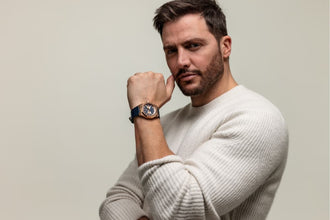

Watches are a part of everyday life. Even with modern technology such as mobile phones, laptops, and TV’s giving us the time whenever we need it, there’s nothing quite like a quality wristwatch.
But when was the first wristwatch invented? And what came before the modern watch? Keep reading to learn all about the history of the modern watch, including sundials, the first mechanical clock, and of course, the first wristwatch.
Ancient Egyptian Sundials
Before clocks and watches, people used sundials to tell the time. This was a surprisingly accurate way of telling the time and is thought that this method was ahead of its time.
Back in 3,500 BC, the Ancient Egyptians constructed obelisks that allowed them to know the time of day by measuring the length of the shadow cast. Ancient Egyptian obelisks were some of the earliest shadow clocks, which was the basis for the popular sundial.
The height of the sun was used to determine the time of day, and the first sundial dates back to 1,500 BC. The oldest sundial features an ‘L’ shape, with the top of the leg casting a shadow on the horizontal leg. However, there were a variety of different shadow-casting devices that people would read to tell the time, whether it be bowl-shaped, step-shaped, or L-shaped.
It was generally the length of the shadow as opposed to the location that determined the time of day it was. However, by the 1st century BC, there were countless sundials in Rome that locals started to get irritated by the sheer number of them. They became far more accurate thanks to the work of geometers of North Africa and astronomers.
The First Mechanical Clock
Modern watches are derived from the very first mechanical clocks. The first mechanical clock dates back to 1275. However, the first mechanical clocks didn’t exactly tell the time, but they did track the time and toll on the hour.
Many town centres and manors had clocks which allowed people to know what hour it was. During this time, blacksmiths were the primary clockmakers, so most mechanical clocks were constructed using iron.
The pendulum clock was invented in the mid-1600s by astronomer Christiaan Huygens, and these soon became the standard timekeeping device.
The First Pocket Watch
The first pocket watch was the beginning of watches - allowing people to tell the time on the go. The very first pocket watch was invented by Peter Henlein, a German watchmaker back at the start of the 1500s.
He managed to use the recent mainsprings advancements to create a smaller design of the watch, which was previously impossible. However, the watch itself wasn’t considered very accurate.
It was the smallest timepiece ever made and was compact enough to carry around. However, they weren't originally placed in pockets - they were attached to a chain around the neck for convenience. It was in the mid-1500s that watches started to be worn as jewellery, with pendant timepieces becoming extremely popular.
The very first pocket watches were rather boxy and uncomfortable and didn’t actually fit into most pockets very well. The pocket watch was redesigned in the 17th century to be even more compact - and was able to live up to its name as a pocket watch.
This coincided with King Charles II’s reign - as he popularised the waistcoat, making them a staple piece of any affluent gentleman’s wardrobe. It became inconvenient and impractical to wear pendants around their necks and was much easier to carry a watch around in their pockets.
Wristwatches were developed shortly, although they weren’t immediately popular - people still thought pendant and pocket watches were the best way of reading the time.
Queen Elizabeth I
Queen Elizabeth I was gifted a watch designed to be worn on the arm back in 1571. It was gifted by Robert Dudley, the 1st Earl of Leicester, who was one of the Queen’s close friends and potential suitors.
This arm watch gift is often a forgotten piece of history as it didn’t cause wristwatches to gain popularity. In fact, the Queen of Naples is often cited as the first person to wear a wristwatch in the early 1800s.
The First Wristwatch
There is plenty of debate as to who actually created the first wristwatch and when it was created, but there have always been the same two names in the running - Patek Philippe and Abraham-Louis Breguet.
It’s only natural that the wristwatch originated in Switzerland - the Guinness World Records states that Swiss watchmaker Patek Philippe invented the first wristwatch back in the 1800s. This was a gift to Countess Koscowicz of Hungary, intended to be worn as a piece of jewellery.
Following this, the wristwatch became a popular accessory as both an accessory and a functional device. So, it appears that it was Patek Philippe who created the first wristwatch.
However, Abraham-Louis Breguet may have actually created the watch decades before Patek. In 1775, Breguet started up his watchmaking store in Paris and went on to create a wristwatch for the Queen of Naples. The Queen of Naples was one of Breguet’s most treasured and affluent clients.
The first reported wear of the watch actually dates back to the early to mid-1600s, worn by Blaise Pascal. Pascal was a French philosopher and mathematician and wore his pocket watch as a wristwatch, attached with a piece of string.
Watches have truly come a long way since then… Read on for our final section - all about the modern wristwatch.
The Modern Wristwatch
In 2022, many watches are made of stainless steel for added durability and for a sleek finish. Modern wristwatches are highly accurate and can last for decades providing that they’re serviced regularly.
Watches in 2022 don’t just tell the time - you can find a watch that gives you the date, functions as an alarm clock, watches that pair to your mobile device, and watches with many features such as a pedometer or a GPS, and even a barometer.
As opposed to just mechanical watches, you can find three main types of wristwatches - manual, automatic, and quartz. If you’re looking for a quality quartz wristwatch, then you can find several collections of luxury yet affordable watches here.







